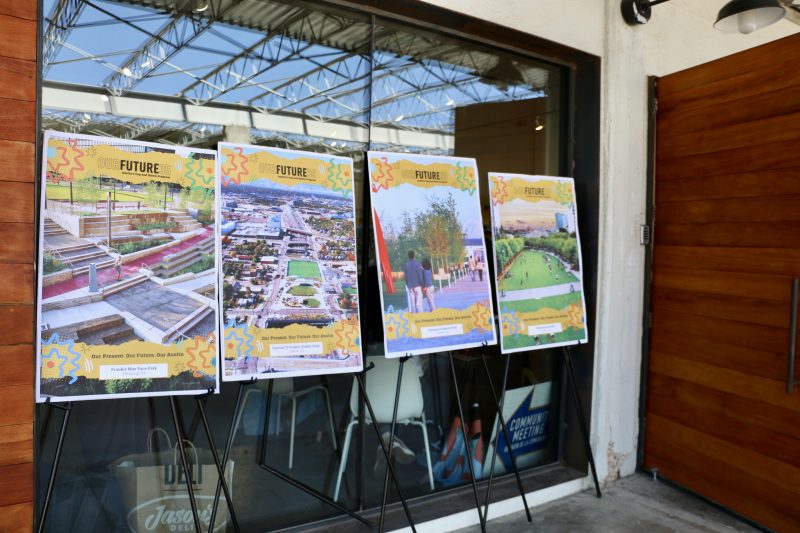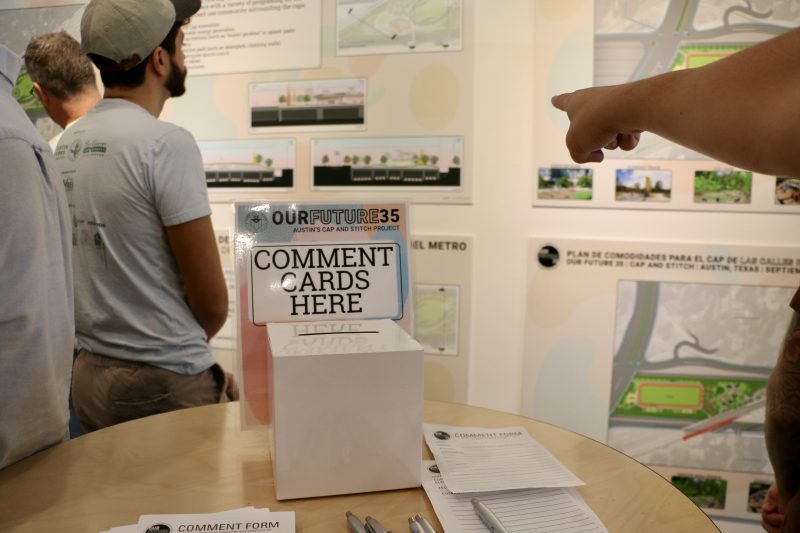Council Considers Reduced I-35 Caps Proposal Amid Concerns of Long-Term Impact
By Madeline de Figueiredo
Photography By Madeline de Figueiredo
Reporting Texas
In Tuesday’s Austin City Council work session, city staff from the Transportation and Public Works Department presented a recommendation to reduce the scope of I-35 caps and stitches, sparking concerns and hesitation among council members and community members about the long-term impact on the city’s future.
While the Our Future 35 Vision Plan originally included eight city-supported potential cap and stitch locations, each stretching over 1,000 feet and encompassing a total of 26.6 acres, city staff recommended Tuesday a scenario with four cap and stitch locations – three located in the downtown area and one located on the north side – each limited to 800 feet and encompassing a total of 12.5 acres.

Signs outside the Our Future 35 public open house on Sept. 28 in Austin, Texas. The city unveiled revised concept sketches for caps to potentially cover portions of Interstate 35 and collected community feedback. Madeline de Figueiredo/Reporting Texas
“This scenario looks at providing as much a cap opportunity as we can along the length of the corridor while trying to be as fiscally as conservative as we can by shrinking the extent of those caps for cost savings,” said Michelle Marx, a transportation planning officer with the city Transportation and Public Works department.
Council members expressed concern about the reduced proposal.
“Having staff’s recommendation be a reduction to 800 feet certainly gave me a lot of pause because the intention of this entire cap and stitch program was really understanding that if we had put the I-35 expansion and renovation to the voters, we don’t know if that would have passed in our community,” Council Member Vanessa Fuentes said voicing her strong support that some downtown caps remain full size. “At this point we are trying to make a silver lining in the project…and really righting the historical harms of having this intersection cut through our city.”
“If we are going to go through the trouble of doing this, my sense would be to go ahead and do full caps and do it right,” Council Member Chito Vela said.
Community members in neighborhoods adjacent to I-35 echoed this hope.
“We ask that our city put together funding to ensure that the roadway elements for all the caps are funded in time to future-proof the caps as part of this multigenerational project,” said Tom Wald, executive director of the Red Line Parkway Initiative.
“A full northern cap would make a huge difference in mitigating the negative impacts of this expansion which are already affecting us,” said Richard Heyman, co-vice chair of the Cherrywood Neighborhood Association. “This would also help connect our neighborhood to central Austin.”
The Texas Department of Transportation has given the city a December deadline to commit to funding cap development. City Council is due to vote on funding for the caps and stitches in their Dec. 12 meeting.
The price tag of this recommended plan is $506 million, including all roadway, deck and tunnel elements, as well as the minimum amenities which only include grass and trees. After accounting for funds from federal grants and a State Infrastructure Bank (SIB) loan, the city’s remaining cost is $360 million.
The full impact on taxpayers remains unclear. One potential funding option is tax increment financing (TIF), but with the City’s budget already heading toward a mandatory tax rate election in the near future, any additional debt issuance could fast-track this process.

Community members attend the Our Future 35 public open house on Sept. 28 in Austin, Texas. The city unveiled revised concept sketches for caps to potentially cover portions of Interstate 35 and collected community feedback. Madeline de Figueiredo/Reporting Texas
If the city commits to the roadway elements by December, it will bear the burden of any cost escalations, with construction funding required by December 2025. Likewise, funding for the deck portion may be necessary as soon as 2026.
Kimberly Olivares, the city’s deputy chief financial officer, warned of cost uncertainties and possible escalations.
“As we move forward we fully anticipate there will be other cost changes that come to light,” Olivares said. “TxDOT is doing their absolute best to keep things in check, but we can’t control everything.”
The project also risks straining the city’s finances Olivares said. Funding for the caps will reduce available debt capacity for other priorities, such as affordable housing and parks. Also, if the decks are included in a 2026 bond election, voter rejection could delay the project for up to three years.
“It has been stated by staff that we are going to have to look at what parks or library improvements or what additional fire stations might have to be pushed down the road and I know that’s not what our constituents want from us,” Council Member Paige Ellis said. “So I want to be very mindful as we move forward that there are a lot of people who see (the caps and stitches) as mitigation for a project that should have had less impact to begin with.”
The timeline for the completion of the caps remains in flux. The Cesar Chavez-4th St. cap will have a federally-mandated completion date of 2031 for roadway and deck elements due to the federal grant, while the other caps do not have a definitive completion date.
City staff projected that amenities for all the caps – such as grass, trees, and potentially other landscape facilities – may be constructed in one or multiple phases starting in 2031, as funding becomes available through partnerships.
Neither the original vision plan nor the staff recommendation included any cap or stitches adjacent to the University of Texas campus, as the city does not intend to allocate any funding for their locations. The University of Texas and TxDOT are directly discussing the potential funding and building of those caps.
“UT is going to their Board of Regents in December to make an investment decision,” said TxDOT transportation planning and development director Heather Ashley-Nguyen. “There is a lot going on underneath the UT caps so we have given them lots of scenarios too to make a decision for us in the same timeframe as the city.”
UT did not respond to a request for comment, but the UT System Regents voted last May to approve a $13.5 million funding agreement with TxDOT for cap or deck structures between East Dean Keeton Street and East 15th Street.
Staff recommended that at council’s next meeting on Dec. 12, council approve key funding agreements for the caps project. This includes authorizing negotiations for an Advanced Funding Agreement (AFA) to secure funding for both roadway elements and full design, accepting an SIB loan, and finalizing a $150 million federal grant agreement with the Federal Highways Administration for the Cesar Chavez-4th St. cap.
“This is a multigenerational project going on and everyone just wants to make sure we get it right,” Council Member Zo Qadri said. “There are a lot of folks who are counting on us.”